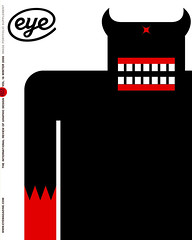Winter 2006
Designer poetry
Ideas Have Legs: Ian McMillan vs Andy Martin
Fuel Publishing, £14.95, USD 25I recently discovered on a visit to my daughter’s primary school how today’s methods of teaching the alphabet differ radically from the way in which I was taught. In a little pamphlet given to all parents entitled My Sounds Book, each letter of the alphabet is accompanied by a physical action. So, alongside the letter ‘a’ is a drawing of a girl wiggling her fingers above her elbow, as if ants were crawling on her; and the child mimics these action while saying: ‘a, a, ants!’ Or, alongside the letter ‘q’ is a drawing of hands clasped together imitating a duck’s beak; while opening and closing their hands the child says: ‘qu, qu, qu, quack!’ The accompanying physical action prompts in the child an associative link between the letter and the movement, all serving to aid learning. Ultimately, it is a behaviourist technique of creating a physical equivalent to thought: performance as a way of learning.
I was reminded of my daughter’s alphabet booklet when I received a copy of Ian McMillan and Andy Martin’s recent collaboration Ideas Have Legs. Once labelled the ‘Shirley Bassey of performance poetry’, McMillan is a native Yorkshireman who presents The Verb, a weekly arts programme on BBC Radio 3, and has appeared on most of the major television networks and radio channels as a guest poet. He has however also remained loyal to his place of birth by working as poet in residence for Barnsley Football Club, Northern Spirit Trains and Humberside Police. Martin was originally an art director for New Musical Express (NME), before going on to establish a career as an image-maker and, more lately, film-maker. It was through a film Martin made of McMillan’s poem ‘Message from a Russian Heatwave’ that the artist and poet first came together. At first glance, it may appear to be an incongruous pairing, but it proves to be an inspired partnership that has produced one of the most enjoyable books of the year. Ideas Have Legs was designed and published by Damon Murray and Stephen Sorrell of Fuel. This beautifully produced collection of McMillan’s poems and Martin’s imagery is a genuine creative union, where the illustrator has sought to visualise the writer’s words.
Like a more advanced and inventive edition of the aforementioned teaching booklet, Martin’s wonderfully eclectic mixture of photographs, collages of found objects, three-dimensional constructions and clever reproductions of printed ephemera, all seek to offer a material form for McMillan’s poems. So, for example, in ‘English / French Mini-Dictionaryscape’ we see how Martin has superimposed a map on a French dictionary, with the ‘places’ in McMillan’s poem acting as both destinations and entries in the book. Or, in ‘Thomas’s first words 10 / 11 / 05’ Martin has scrawled on a children’s blackboard the six words of the poem, giving rise to a perfect amalgamation of form and content. Martin’s imaginative understanding of McMillan’s works is not so far in ambition from the original aims of concrete poetry. However, unlike concrete poetry, it is not limited to exploring the expressive potential of typography. Rather, his compositions seek to exploit the calculated ambiguity of McMillan’s writing via all possible visual forms.
Ideas Have Legs achieves its most engaging visual-verbal arrangements with Martin’s illustrations for McMillan’s prose poems. When McMillan’s poetry takes the form of an everyday conversation, Martin’s eye for the remarkable in the ephemeral comes to the fore. In McMillan’s hands, a mispronounced word, a forgotten word, a word repeated, is suddenly made strange or funny; or the most banal sign, room, or conversation is cast in an uncanny light; Martin then takes this and seeks to provide something more than a simple simulacrum of McMillan’s ideas.
In poems such as ‘CC is my wife in a dream’ or ‘He typed Bat instead of Boat’ the surreal nature of McMillan’s observations on the absurdities of everyday life find a corollary in Martin’s use of old labels, billposters, lettering, and photographic images. In such moments, by dissolving the barriers between image and text, or, more accurately, amplifying this relationship, Martin finds a visual equivalent for how poetry thinks. Through Martin and McMillan’s book, ideas have, not legs, but wings.
Kerry William Purcell, design historian, London
First published in Eye no. 62 vol. 16 2006
Eye is the world’s most beautiful and collectable graphic design journal, published quarterly for professional designers, students and anyone interested in critical, informed writing about graphic design and visual culture. It is available from all good design bookshops and online at the Eye shop, where you can buy subscriptions and single issues.

